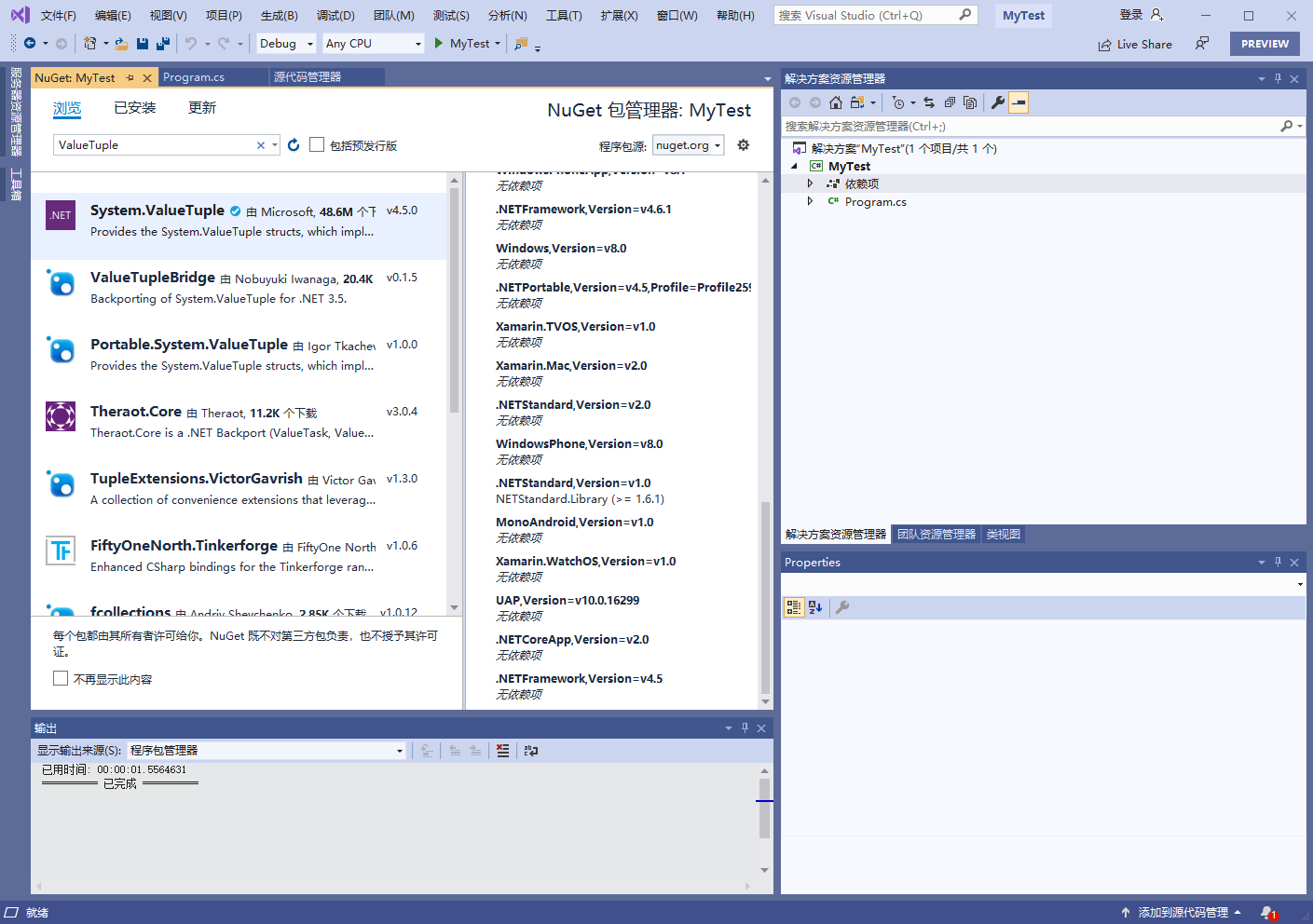
什么是元组
元组是 C# 提供的简单定义的类型,早期版本为 System.Tuple,使用该类型可以简化类型的定义。
// 姓名 性别 出生日期
Tuple<string, bool, DateTime> person = new Tuple<string, bool, DateTime>("John", true, new DateTime(1990, 01, 01));
Console.WriteLine($"{person.Item1} is a good {(person.Item2 ? "boy" : "girl")} and {(person.Item2 ? "his" : "her")} birthday is on {person.Item3.ToString("MM.dd")}");
如上,可以组装多个类型成为一个新的类型,可以应用在多返回值或一些数组集合场景下。
// 多返回值:是否执行成功 错误信息
public Tuple<bool, string> Execute(string sql)
{
bool result = false;
string message = null;
try
{
result = SqlHelper.Excute(sql);
}
catch (Exception exc)
{
message = $"错误信息:{exc.Message}\n堆栈信息:{exc.StackTrace}";
}
return new Tuple<bool, string>(result, message);
}
// 特殊类型集合
public void Test()
{
List<Tuple<string, bool, DateTime>> people = new List<Tuple<string, bool, DateTime>>();
people.Add(new Tuple<string, bool, DateTime>("John", true, new DateTime(1990, 01, 01)));
people.Add(new Tuple<string, bool, DateTime>("Jane", false, new DateTime(1992, 02, 02)));
foreach (var item in people)
{
Console.WriteLine($"{item.Item1} is a good {(item.Item2 ? "boy" : "girl")} and {(item.Item2 ? "his" : "her")} birthday is on {item.Item3.ToString("MM.dd")}");
}
}
但是该类型使用时还是有一些缺陷,特别是通过 Item{n} 标记元素,没有具体的含义在使用中就比较容易出错。
另外,其泛型参数只提供了 7 个,如果超过 7 个,我们就要使用第 8 个泛型参数使用 System.Tuple 类型进行嵌套,例如:
// 定义多个参数
Tuple<int, int, int, int, int, int, int, Tuple<int>> nums = new Tuple<int, int, int, int, int, int, int, Tuple<int>>(1, 2, 3, 4, 5, 6, 7, new Tuple<int>(8));
所以微软在后来提供了 System.ValueTuple 类型,取代了 System.Tuple,我们可以通过 NuGet 引用 System.ValueTuple 使用。

如上图所示,其标记的支持 .NET Framework 的最低版本为 .NET Framework 4.5,但实际上我们给 .NET Framework 4.0 的项目引用依然是可以正常使用的。另外如果想在 .NET Framework 3.5 的项目中使用,可以引用上图中的 ValueTupleBridge。
ValueTuple 的语法
首先我们使用 NuGet 添加对 System.ValueTuple 的引用,我们可以将以上 Tuple 部分定义的内容进行简单的重写:
// 多返回值:是否执行成功 错误信息
public (bool result, string message) Execute(string sql)
{
bool result = false;
string message = null;
try
{
result = SqlHelper.Excute(sql);
}
catch (Exception exc)
{
message = $"错误信息:{exc.Message}\n堆栈信息:{exc.StackTrace}";
}
return (result, message);
}
// 特殊类型集合
public void Test()
{
List<(string name, bool sex, DateTime birthday)> people = new List<(string name, bool sex, DateTime birthday)>();
people.Add(("John", true, new DateTime(1990, 01, 01)));
people.Add(("Jane", false, new DateTime(1992, 02, 02)));
foreach (var item in people)
{
Console.WriteLine($"{item.name} is a good {(item.sex ? "boy" : "girl")} and {(item.sex ? "his" : "her")} birthday is on {item.birthday.ToString("MM.dd")}");
}
}
// 定义多个参数
(int num1, int num2, int num3, int num4, int num5, int num6, int num7, int num8) nums = (1, 2, 3, 4, 5, 6, 7, 8);
此外我们还可以用多种方式来声明 System.ValueTuple:
- 将元组赋给单独声明的变量
(string name, bool sex, DateTime birthday) = ("John", true, new DateTime(1992, 02, 02)); Console.WriteLine($"{name} is a good {(sex ? "boy" : "girl")} and {(sex ? "his" : "her")} birthday is on {birthday.ToString("MM.dd")}"); - 将元组赋给预声明的变量
string name; bool sex; DateTime birthday; (name, sex, birthday) = ("John", true, new DateTime(1992, 02, 02)); Console.WriteLine($"{name} is a good {(sex ? "boy" : "girl")} and {(sex ? "his" : "her")} birthday is on {birthday.ToString("MM.dd")}"); - 将元组赋给单独声明和隐式类型的变量
(var name, var sex, var birthday) = ("John", true, new DateTime(1992, 02, 02)); Console.WriteLine($"{name} is a good {(sex ? "boy" : "girl")} and {(sex ? "his" : "her")} birthday is on {birthday.ToString("MM.dd")}"); - 将元组赋给单独声明和隐式类型的变量,但只用一个
varvar (name, sex, birthday) = ("John", true, new DateTime(1992, 02, 02)); Console.WriteLine($"{name} is a good {(sex ? "boy" : "girl")} and {(sex ? "his" : "her")} birthday is on {birthday.ToString("MM.dd")}"); - 声明具名元组,将元组值赋给它,按名称访问元组项
(string name, bool sex, DateTime birthday) person = ("John", true, new DateTime(1992, 02, 02)); Console.WriteLine($"{person.name} is a good {(person.sex ? "boy" : "girl")} and {(person.sex ? "his" : "her")} birthday is on {person.birthday.ToString("MM.dd")}"); - 声明包含具名元组项的元组,将其赋给隐式类型的变量,按名称访问元组项
var person = (name: "John", sex: true, birthday: new DateTime(1992, 02, 02)); Console.WriteLine($"{person.name} is a good {(person.sex ? "boy" : "girl")} and {(person.sex ? "his" : "her")} birthday is on {person.birthday.ToString("MM.dd")}"); - 将元组项未具名的元组赋给隐式类型的变量,通过项编号属性访问单独的元素
var person = ("John", true, new DateTime(1992, 02, 02)); Console.WriteLine($"{person.Item1} is a good {(person.Item2 ? "boy" : "girl")} and {(person.Item2 ? "his" : "her")} birthday is on {person.Item3.ToString("MM.dd")}"); - 将元组项具名的元组赋给隐式类型的变量,但还是通过项编号
var person = (name: "John", sex: true, birthday: new DateTime(1992, 02, 02)); Console.WriteLine($"{person.Item1} is a good {(person.Item2 ? "boy" : "girl")} and {(person.Item2 ? "his" : "her")} birthday is on {person.Item3.ToString("MM.dd")}"); - 赋值时使用下划线丢弃元组的一部分(弃元)
(string name, bool sex, DateTime birthday, _) = ("John", true, new DateTime(1992, 02, 02), "China"); - 通过变量和属性名推断元组项名称(
C# 7.1新增)string name = "John"; bool sex = true; DateTime birthday = new DateTime(1990, 01, 01); var person = (name, sex, birthday); Console.WriteLine($"{person.name} is a good {(person.sex ? "boy" : "girl")} and {(person.sex ? "his" : "her")} birthday is on {person.birthday.ToString("MM.dd")}");
注意:
- 元组是在对象中封装数据的轻量级方案,元组数据项的类型没有限制,但是他们的类型是由编译器决定,不能在运行时改变。
- 如果需要对封装的数据关联行为(事件、方法),应该创建一个类而不是使用元组。
- 元组
System.ValueTuple类似结构体,如果将一个元组赋值给另外一个元组,其是值传递而非引用传递。


